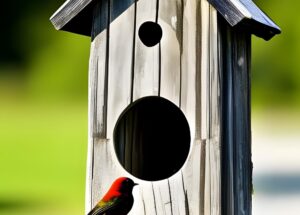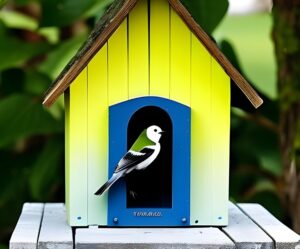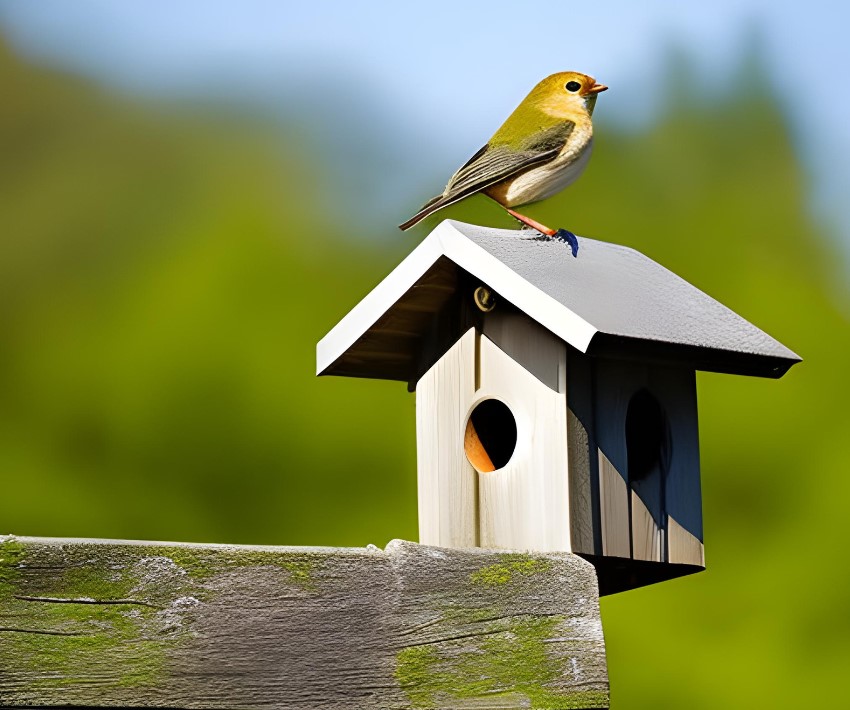Do you love watching birds fly around your backyard? Have you ever thought about providing a cozy home for them to live in too? Many people hang birdhouses in their yards, but do the birds actually like living in them?
Birds are fascinating creatures that come in all shapes and sizes. Some prefer to build their nests high up in trees, while others may choose to nest on the ground. But what about bird houses – do they really attract our feathered friends? In this article, we will explore whether or not birds enjoy hanging out in bird houses and some tips for making sure your avian neighbors feel at home.
The Purpose Of Bird Houses
Bird houses are a popular way to attract birds to your yard. They provide shelter and nesting spaces for the feathered creatures, which can be enjoyable to watch. However, it is essential to understand that bird house effectiveness varies depending on several factors.
While bird houses may seem like the perfect solution for attracting birds, they’re not always necessary. Birds often prefer natural habitats such as trees or shrubs over man-made structures. Therefore, if you have plenty of greenery in your garden, you might not need a bird house.
If you still want to use a birdhouse in your yard, keep in mind that proper placement is crucial. The location should be away from potential predators such as cats and squirrels while providing adequate sunlight and shade throughout the day. With all these considerations in mind, you can make an informed decision about whether or not a birdhouse is right for your garden.
Understanding bird behaviors plays an important role in creating a suitable habitat that attracts them naturally. Let’s take a closer look at what birds like and how we can meet their needs without relying solely on artificial structures such as birdhouses.
Understanding Bird Behaviors
Birds are interesting creatures with unique behaviors. Understanding their behavior is essential for bird feeding and bird watching enthusiasts. One of the common questions asked by many people is whether birds like hanging bird houses.
Firstly, it’s important to note that not all birds use birdhouses. Some prefer building nests on trees or bushes. However, some species such as bluebirds and chickadees love using birdhouses as their homes.
Secondly, when setting up a birdhouse, consider factors such as location, size, and materials used in construction. A good rule of thumb is to place the house away from direct sunlight and predators’ reach while also ensuring there is enough space around for easy access.
Now that you understand why birds enjoy hanging out in birdhouses let’s talk about choosing the right one!
Choosing The Right Bird House
- When choosing a bird house, it’s important to consider size, location, design, and materials.
- You’ll also want to make sure it’s easy to clean, accessible, and well-ventilated.
- After that, you’ll need to think about safety, weatherproofing, and how much nesting and perching space it offers.
- Finally, you should check to make sure it has an entrance hole, drainage, and that it won’t require too much maintenance.
Size
Picture this: you’re strolling through the park on a sunny afternoon, and in the distance, you spot a cute birdhouse hanging from a tree. Have you ever wondered why some birds prefer certain types of houses over others? One important factor to consider is the size of the birdhouse.
Birds come in all shapes and sizes, so it’s essential to choose a house that accommodates their needs. A larger bird house may attract bigger birds such as blue jays or robins. On the other hand, smaller species like chickadees or wrens will appreciate something more snug and cozy. It’s crucial to select a birdhouse size that matches the type of bird you want to attract.
The style of your birdhouse can also affect its size requirements. For example, if you opt for an enclosed design with only one entrance hole, make sure it’s large enough for your desired species to enter comfortably. Ultimately, choosing the right birdhouse size means taking into account both the physical dimensions of your feathered friends and their preferences for different styles of homes.

Location
Now that we know the importance of selecting the right size for a birdhouse, let’s talk about another crucial factor: location. When it comes to placing your birdhouse, you have two options: indoor or outdoor placement. Indoor birdhouses are typically used for decoration and not intended for actual birds to live in. On the other hand, an outdoor birdhouse is designed specifically for birds to use as shelter.
When deciding on where to place your outdoor birdhouse, height is also a key consideration. Different species of birds prefer different heights when it comes to nesting. For example, bluebirds prefer their houses placed between 5-10 feet high, while chickadees like theirs closer to the ground at around 3-5 feet high. It’s important to research each type of bird and its preferred height before installing your house.
Overall, finding the right location for your birdhouse can greatly impact whether or not birds will choose to inhabit it. By considering both indoor vs outdoor placement and proper height options, you can create an inviting space for feathered friends in your backyard without any trouble!
Placement And Positioning
Now that you have chosen the right bird house, it’s important to place it in the best location. The ideal height for a birdhouse is between 5 and 10 feet above ground level. This ensures that it is high enough to protect birds from predators but not too high that they are unable to fly up to it.
When deciding where to place your birdhouse, consider shade and sunlight as well as weather protection. Birds prefer shaded areas during hot summer months so avoid placing the birdhouse in direct sunlight all day long. However, make sure the birdhouse also receives some sunlight each day for warmth and drying purposes. Additionally, be sure to provide some form of weather protection such as an overhang or roof on top of the birdhouse.
Now that you know about placement and positioning, let’s talk about materials and design for your birdhouse. It’s important to choose a material that will withstand various weather conditions such as rain, wind, and snow. Common materials used for birdhouses include wood, PVC pipe, and metal. When designing your birdhouse, keep in mind the size of the entrance hole which should be specific to the type of bird you want to attract. With these factors in mind, you’ll be able to create a safe and comfortable home for your feathered friends!
Materials And Design
Birdhouses are a great way to attract birds to your yard or garden. Design styles and construction materials play an important role in ensuring that the birdhouse is a welcoming place for our feathered friends.
Design styles can range from simple to ornate, depending on personal preference. Some popular design styles include traditional wooden houses, modern metal structures, and whimsical shapes like teapots or boots. Whatever the style may be, it’s important to ensure that the entrance hole is the right size for the intended bird species.
Construction materials also vary greatly and can affect not only the aesthetic but also the durability of the birdhouse. Common materials used include wood, metal, plastic, and even recycled materials such as old license plates or milk jugs. It’s essential to choose high-quality materials that can withstand weather conditions and provide insulation for the birds during extreme temperatures.
When selecting a birdhouse, keep in mind both design styles and construction materials. A well-designed and constructed house will not only attract birds but also serve them well throughout their stay. In addition to these factors, cleaning and maintenance are critical components of keeping your birdhouse safe and functional for years to come.
Cleaning And Maintenance
Cleaning bird houses is important to keep them looking nice and healthy. You’ll need some tools and supplies like a ladder, a brush, and a hose. To clean a bird house, you can use warm water and soap. Maintaining a bird house means checking it often to make sure it’s in good condition. You should also watch out for any signs of damage. Finally, birds love hanging bird houses, so make sure you keep yours looking nice!
Cleaning Bird Houses
Have you ever wondered if birds like hanging birdhouses? Well, they actually do! But as much as they love their little homes, it’s important to keep them clean and well-maintained. Deep cleaning your birdhouse is crucial for the health and safety of our feathered friends.
Frequency of cleaning is also essential in keeping a healthy environment for birds. The ideal time to clean out your birdhouse is when it is no longer being used by its previous inhabitants or at least once a year during fall or winter. This prevents any bacteria buildup that could potentially harm future nesting birds.
To deep clean your birdhouse, start by removing all debris from inside the house using gloves and a small brush. Then, use a solution of one-part vinegar to nine-parts water to scrub down the entire interior and exterior of the house with a stiff-bristled brush. Rinse thoroughly with warm water before allowing it to dry completely in direct sunlight. With proper maintenance, your feathered friends will continue loving their cozy home year after year!
Tools And Supplies
Now that we know how important it is to keep our birdhouses clean, let’s talk about the tools and supplies needed for cleaning and maintenance. First, you will need gloves to protect your hands from any debris or bacteria inside the house. You’ll also need a small brush to remove all the old nesting materials and droppings.
For deep cleaning, vinegar diluted with water can be used as a natural solution. A stiff-bristled brush should be used to scrub down both the interior and exterior of the house thoroughly. After rinsing with warm water, allow the birdhouse to dry completely in direct sunlight before replacing it in its original location.
When buying a new birdhouse, consider one with easy access for future cleaning and maintenance. Additionally, installation tips such as placing it away from predators and at least five feet off the ground should be followed to ensure safety for birds. Remember these tools, supplies, and tips to provide a healthy environment for our feathered friends!
Maintaining Bird Houses
Now that we’ve learned how to clean a birdhouse, let’s talk about maintaining it. Maintaining your birdhouse means keeping it in good condition and making sure it’s safe for the birds. One way to maintain your birdhouse is by decorating it with non-toxic paint or stain. However, be sure not to use anything harmful to birds.
Another important aspect of maintaining a birdhouse is safety. Make sure you’re placing the house away from predators such as cats or squirrels. It should also be at least five feet off the ground so that animals cannot reach it easily. Additionally, if you notice any damage to the house or its structure, repair it immediately before putting it back up.
Remember, cleaning and maintenance go hand in hand when it comes to birdhouses. By taking proper care of your feathered friends’ homes, you can provide them with a healthy environment they’ll want to come back to year after year!

Attracting And Encouraging Birds To Visit
After cleaning and maintaining your bird house, it’s time to think about how you can attract birds to visit. One of the ways is through bird house decoration. Birds are attracted to colorful objects, so consider painting your bird house with bright colors or decorating it with flowers.
Another important factor in attracting birds is the placement of your bird house. Place it in an area that has plenty of trees and bushes nearby for cover and protection from predators. It should also be placed at a height where humans cannot easily access it but still accessible enough for regular maintenance.
Providing a bird house in your backyard not only attracts beautiful creatures but also offers benefits such as insect control and pollination. With proper decoration and placement, you can create a welcoming environment for different types of birds to come and nest in your yard.
Benefits Of Providing Bird Houses In Your Backyard
Bird houses are a great addition to any backyard, and they offer many benefits for birds. Providing a safe place for birds to nest can help increase their population in your area. Plus, it’s fun to watch the birds come and go from their new home.
Bird house placement is important when setting up your backyard bird sanctuary. You want to make sure that the bird house is high enough off the ground so predators cannot reach it easily. Also, placing the bird house near trees or bushes provides shelter for the birds as well.
DIY bird houses are also an option if you’re feeling crafty. Building your own bird house not only saves money but allows you to create a unique design tailored specifically to your backyard décor.
Here are some other benefits of providing bird houses:
- Encourages natural pest control by attracting insect-eating birds
- Provides entertainment and education for children
- Helps with flower pollination
- Enhances overall backyard aesthetic
- Gives back to nature by creating a safe haven for our feathered friends – Helps to support declining bird populations by providing additional nesting options.
Frequently Asked Questions
How Do Hanging Bird Houses Compare To Those Mounted On Poles Or Trees?
Hanging bird houses and those mounted on poles or trees both have their advantages and disadvantages. Hanging bird houses are easy to install, but they can sway in the wind, which might make birds feel uncomfortable. On the other hand, mounting a bird house on a pole or tree provides stability and safety for birds. Bird houses that are attached to poles or trees also give an opportunity for homeowners to observe the birds safely without disturbing them. This makes it easier for people to learn about different types of birds and how they live. Overall, while hanging bird houses may be more convenient, mounting them on poles or trees creates a safer environment for our feathered friends while providing benefits for humans too.
Can Certain Colors Or Designs Attract Specific Types Of Birds?
Did you know that the color and design of a bird house can attract specific types of birds? For example, bluebird houses are often painted blue to attract these beautiful creatures. When it comes to placement, it’s important to make sure the bird house is high enough off the ground so predators cannot reach it. And don’t forget about maintenance! Clean out your bird house regularly to prevent disease and ensure a welcoming environment for our feathered friends.
What Are Some Common Mistakes To Avoid When Placing Bird Houses?
When placing bird houses, it’s important to remember a few things. First, the proper height is crucial – generally between 5 and 15 feet above ground level. Second, location matters! Avoid placing bird houses near busy areas or where there may be predators lurking around like cats or squirrels. Thirdly, make sure your bird house has predator avoidance features such as baffles or squirrel guards. Lastly, ventilation is key to keep birds from overheating in the summer months. By following these simple tips, you’ll help create a safe and comfortable home for our feathered friends!
Is It Necessary To Provide Nesting Material Or Food For The Birds?
Birdhouse requirements are important to attract bird species. Nesting material is necessary for birds to build their nests, so it’s a good idea to provide some in the birdhouse. Food is also helpful and can be provided through feeders or by planting native plants that produce seeds, berries, or nectar. By meeting these basic requirements, you can create an inviting environment for birds to visit your yard and raise their young in your hanging bird houses!
How Long Do Bird Houses Typically Last Before Needing To Be Replaced?
Bird houses are a great way to provide benefits for birds, such as shelter and protection from predators. However, they do require maintenance over time. Typically, bird houses can last anywhere from 1-5 years before needing to be replaced due to wear and tear or damage caused by weather conditions. It’s important to regularly clean the bird house and make any necessary repairs in order to keep it safe and comfortable for the birds that may use it as their home.
Conclusion
So, do birds like hanging bird houses? Well, it turns out that they actually like all kinds of bird houses! Whether you hang them up or mount them on a pole or tree, birds will happily make their homes in any type of bird house.
But if you want to attract specific types of birds, choosing the right color and design can help. And while providing nesting material and food isn’t necessary for the birds to use the house, it can certainly make their stay more comfortable. Just remember to avoid common mistakes when placing the house and keep an eye on its condition over time. With these tips in mind, you’ll be sure to have some happy feathered friends making a home in your backyard!

